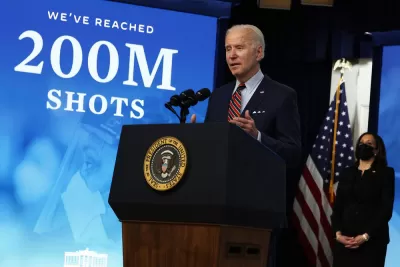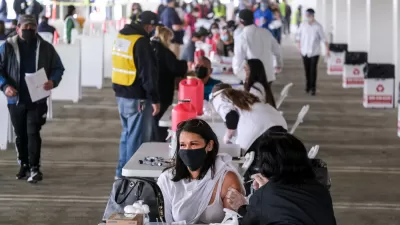The 'light at the end of the tunnel' has become brighter after the vaccination rate tripled since President Biden took office. According to an analysis, a vaccination enthusiasm tipping point will be reached in 2-4 weeks that could dim the light.

"Today, we hit 200 million shots on the 92nd day in office," stated President Joe Biden in a speech from the White House on April 21 marking the second vaccination target his health team has met in the administration's first 100 days.
You know, at the pace we were moving when I took office, it would have taken us more than 220 days — almost seven months — seven and a half months — to reach 200 million shots. Instead of marking this milestone in April, we would not have seen it until early September at the earliest.
Now that we’ve reached this milestone, we’re entering a new phase of our vaccination effort. As of Monday, at my direction, with the support of 50 governors — Democrats and Republicans, alike — everyone over the age of 16 will be [is now] eligible to get vaccinated.
The eligibility milestone was also noted by the Kaiser Family Foundation, a nonprofit organization focusing on national health issues, in an analysis of vaccine supply and demand released on Tuesday (source article).
Now, with supply having increased significantly and eligibility fully open to adults in all states as of April 19, the main question has become, when will supply outstrip demand?
While timing may differ by state, we estimate that across the U.S. as a whole we will likely reach a tipping point on vaccine enthusiasm in the next 2 to 4 weeks. Once this happens, efforts to encourage vaccination will become much harder, presenting a challenge to reaching the levels of herd immunity that are expected to be needed.
The analysis is partly based on the extensive and detailed polling by the foundation on demand for the COVID-19 vaccines.
"Federal, state, and local officials, and the private sector, will face the challenge of having to figure out how to increase willingness to get vaccinated among those still on the fence, and ideally among the one-fifth of adults who have consistently said they would not get vaccinated or would do so only if required," write Jennifer Kates, Larry Levitt, and Josh Michaud of the foundation.
Politico also noted the upcoming vaccine challenge in their report on the president's speech.
"The [president's] announcements come as the administration is reaching a new turning point in its campaign to vaccinate over 300 million Americans: Supply is beginning to exceed demand, and appointments are going unfilled in both rural areas and big cities," wrote Quint Forgey and Rachel Roubein.
The problem goes beyond vaccine hesitancy and extends to Americans who have neither easy access to the shot nor the motivation to get vaccinated. State and federal officials say the focus is now on meeting people where they are.
Grant County, Oregon
What the Kaiser Family Foundation predicts will soon happen nationwide is already occurring in Oregon's coronavirus hotspot. The state is seeing a surge in new infections. The Washington Post coronavirus database shows a 27% increase in cases during the last week, although case incidence, 16 per 100,000 people, remains below the national average of 19 per 100k, on April 22.
Upon closer look at the Beaver State, Grant County has the most severe outbreak. Case incidence is 147 per 100k for the county of 7,200 people, according to Covid Act Now. The next highest is Klamath County, pop. 68,000, at 51 per 100k. By comparison, the nation's hotspot, Michigan, has 64 per 100k.
The local paper, the weekly Blue Mountain Eagle, observed on April 13 that the county last week "had the highest rate of COVID-19 infections per capita in Oregon, and the county also has the worst vaccination rate in the state."
"On Sunday [April 11], Kimberly Lindsay, Grant County public health administrator, estimated that around 30% of the county’s residents are partially or fully vaccinated," reported Steven Mitchell. "Lindsay said the county has stopped requesting additional vaccine doses from the Oregon Health Authority because of a lack of demand."
Greg Armstrong, the owner of Len’s Drug, told the Eagle they have more doses at the pharmacy than people coming in to getting the shot.
“I am very concerned,” Lindsay said. “With 70% unvaccinated, that leaves just over 5,000 people available for COVID-19 to move through freely. That’s a lot of room to roam.
Related in Planetizen:
-
Pandemic Endgame: The Goalposts are Moving, December 30, 2020
FULL STORY: Supply vs Demand: When Will the Scales Tip on COVID-19 Vaccination in the U.S?

Maui's Vacation Rental Debate Turns Ugly
Verbal attacks, misinformation campaigns and fistfights plague a high-stakes debate to convert thousands of vacation rentals into long-term housing.

Planetizen Federal Action Tracker
A weekly monitor of how Trump’s orders and actions are impacting planners and planning in America.

In Urban Planning, AI Prompting Could be the New Design Thinking
Creativity has long been key to great urban design. What if we see AI as our new creative partner?

King County Supportive Housing Program Offers Hope for Unhoused Residents
The county is taking a ‘Housing First’ approach that prioritizes getting people into housing, then offering wraparound supportive services.

Researchers Use AI to Get Clearer Picture of US Housing
Analysts are using artificial intelligence to supercharge their research by allowing them to comb through data faster. Though these AI tools can be error prone, they save time and housing researchers are optimistic about the future.

Making Shared Micromobility More Inclusive
Cities and shared mobility system operators can do more to include people with disabilities in planning and operations, per a new report.
Urban Design for Planners 1: Software Tools
This six-course series explores essential urban design concepts using open source software and equips planners with the tools they need to participate fully in the urban design process.
Planning for Universal Design
Learn the tools for implementing Universal Design in planning regulations.
planning NEXT
Appalachian Highlands Housing Partners
Mpact (founded as Rail~Volution)
City of Camden Redevelopment Agency
City of Astoria
City of Portland
City of Laramie




























